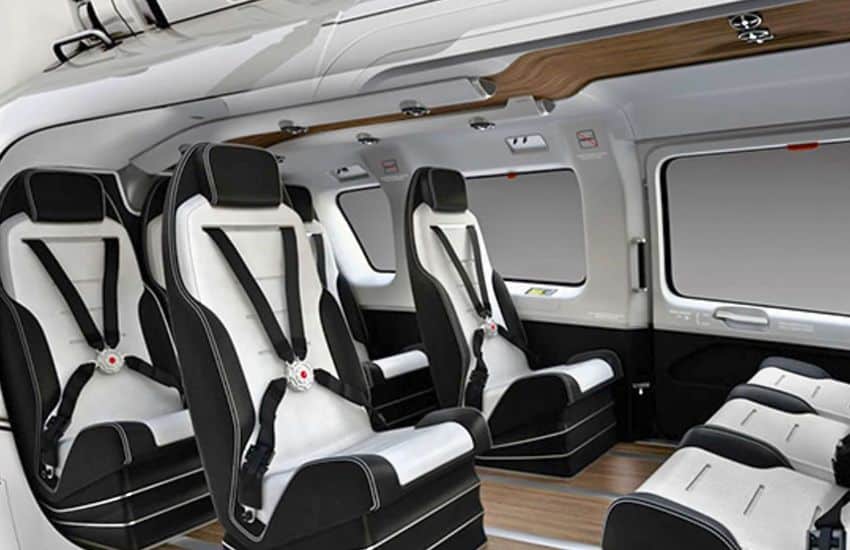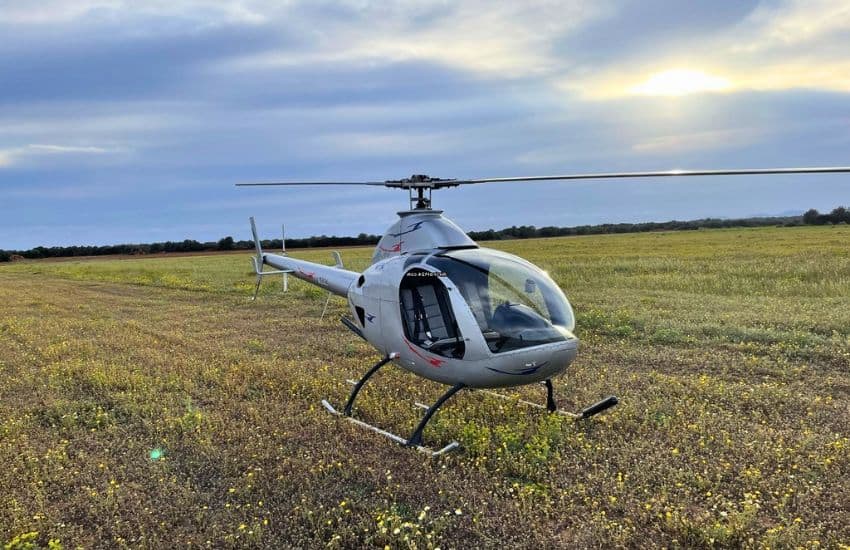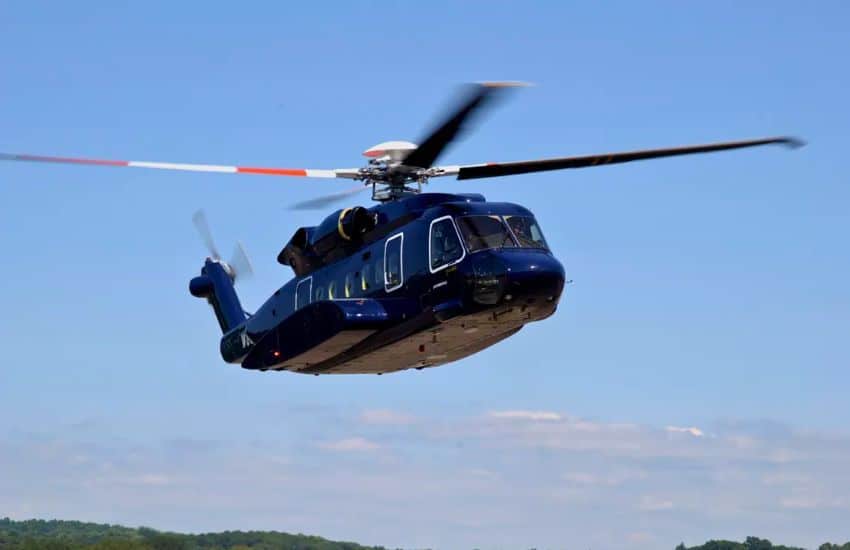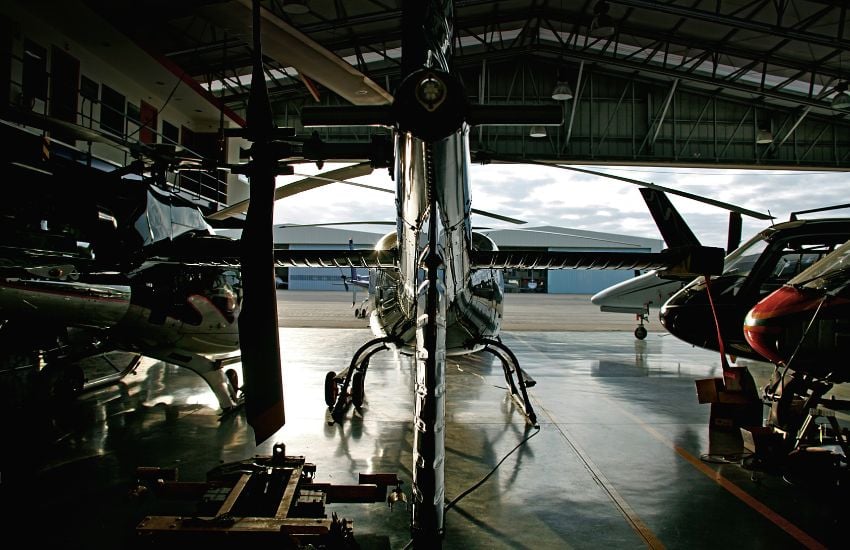When we gaze up at the sky and see a helicopter gracefully hovering above, it’s hard not to wonder about the price tag that comes with such a marvelous machine. You can own one for at least $100,000 or splurge millions for a luxury option. Or, rent one for a few hundred bucks. We’ll explore the various price points and factors that influence the cost, providing you with a clearer understanding of what it takes to enter the world of helicopter enthusiasts.
Known Helicopter Manufacturers
Helicopter manufacturing is a specialized field with several well-known companies around the world that design, produce, and sell helicopters. Some well-known helicopter manufacturers you’ll come across with include:

Airbus Helicopters
Formerly originally famous as Eurocopter, Airbus Helicopters has a strong presence in both civil and military markets, hailed as one of the world’s big players in aircraft manufacturing. Airbus produces a diverse range of helicopters, including the popular H125 (formerly AS350) used for various missions, and the H145, a versatile twin-engine rotorcraft for various applications.
Bell Helicopter
A subsidiary of Textron Inc., this brand is another trusted and well-known option in the industry with a rich history of producing iconic rotorcraft. Bell’s portfolio includes well-known helicopters like the Bell 206 JetRanger, popularly helping in military training and light transport, and the Bell 407, a versatile single-engine suitable for a range of missions.
Sikorsky Aircraft
A subsidiary of Lockheed Martin, Sikorsky is a renowned manufacturer specializing in military and civil helicopter production, known for its UH-60 Black Hawk, a versatile and widely used military helicopter, and the S-92, a twin-engine helicopter known for its safety features and comfort.
Leonardo Helicopters
Formerly known as AgustaWestland, Leonardo Helicopters is known for its expertise in helicopter design and manufacturing. The medium-sized AW139 with its twin-engine helicopter, and the AW109, another twin-engine model but lighter, are some of their well-regarded products.
Robinson Helicopter Company
Robinson is a U.S.-based manufacturer that focuses on producing affordable and lightweight helicopters, often used for training and personal transportation. Robinson’s lineup includes the Robinson R22 and R44, which are widely used for training and recreational flying.
Kamov
A Russian helicopter manufacturer, Kamov is notable for its unique coaxial rotor design like in Ka-52, a versatile attack helicopter, and the Ka-226, specified for various civilian missions, are among Kamov’s offerings.
MD Helicopters
MD Helicopters specializes in producing single-engine and light models like the MD 500 series, known for its affordability and versatility, the company’s primary product lines.
Russian Helicopters
Russian Helicopters is a Russian manufacturer that offers a diverse portfolio of rotorcraft for different purposes, with a strong focus on military and civilian applications. The Mi-8 and Mi-17 made for military missions, and the Kamov Ka-226 for civilian applications are some of their key models.
Kawasaki Heavy Industries
Kawasaki Heavy Industries, a Japanese company, is known for producing helicopters used in various roles. The BK117, used in emergencies like medical evacuations and police operations, and the OH-1, a Japanese military observation helicopter, are part of their portfolio.
Enstrom Helicopter Corporation
Enstrom is a U.S.-based manufacturer that specializes in producing lightweight utility and training helicopters. The Enstrom F28 and 480B are known for their simplicity and suitability for training and light transport.
These manufacturers offer a wide range of helicopters tailored to meet the specific needs of customers in diverse sectors, such as military, law enforcement, medical services, and private aviation. The choice of manufacturer and model depends on factors such as mission requirements, budget, and operational preferences.
What dictates helicopter prices?
Helicopter prices are a puzzle, and like all complex machines, they are the product of multiple intricate elements. If you’re wondering what determines the price tag of these soaring wonders, you’re in for an interesting journey.

Type and Model
The make and model of a helicopter are like its DNA, shaping its price. There’s a diverse world of helicopters out there, ranging from the lightweight choppers to intermediate and heavy-duty beasts, each designed for specific missions like personal travel, utility work, medical evacuations, law enforcement, or military missions. The fancier and more specialized the model, the higher the price.
Passenger Capacity and Cargo
Size is a significant player in the price game. Bigger helicopters with room for more passengers or the ability to carry substantial cargo tend to come with a heftier price tag.
Engine Type and Performance
The engine under the hood makes a difference too. Turbine engines are like the high-performance race cars of the helicopter world, and they often come at a premium due to their reliability, power, and maintenance costs.
Avionics and Equipment
Gadgets and gizmos matter. The tech and equipment, from navigation systems to instrumentation, can be basic or super advanced, and they’ll influence the price accordingly.
Customization
Want to make it your own? Customization lets you add personal touches like interior design, seating setups, and extra gadgets. Just remember, custom features can jack up the price.
The Brand Name
Brands matter, and in the world of helicopters, established manufacturers with a solid track record can charge more for their reputation of quality and reliability.
Age, Condition, and Market Demands
Pre-owned helicopters are usually more budget-friendly, but their age, flight hours, and overall shape matter. The location also plays a role; helicopters in high-demand areas might come at a higher price due to market dynamics.
Operating Costs
Owning a helicopter means you’ll need to consider more than just the buying price. Maintenance, fuel, insurance, and day-to-day expenses all play a role in the overall cost.
Regulations and Rules
Lastly, helicopters need to jump through regulatory hoops to take to the skies. Meeting these standards can add extra costs to design, testing, and ensuring compliance.
Prospective buyers should do their homework and weigh these factors carefully when hunting for the right helicopter. Prices can take off or hover closer to the ground depending on what you’re looking for and how you plan to use it. Seek advice from experienced aviation pros like helicopter dealers and maintenance experts to make informed choices.
Private Use Helicopter Models and Cost
Here’s the estimated average cost for private use helicopters. Please keep in mind that they may change so do your research to stay up to date with the latest rates:
| Model | Use | Price est. |
| Robinson R44 | Private Use | $400,000 to $600,000 |
| Bell 505 Jet Ranger X | Private Use | $1.2 to $1.5 million |
| Airbus H130 | Private Use | Around $3 million |
| Sikorsky S-76 | Private Use | $7 million to $13 million |
| AgustaWestland AW109 | Private Use | $7 million to $9 million |
| Bell 429 GlobalRanger | Private Use | $6 million to $7 million |
Commercial Use Helicopter Models and Cost
If you’re interested in helicopters for commercial use, here are some of the models and their estimated prices:
| Model | Use | Price est. |
| Bell 206B | Commercial | $1.5 million |
| Airbus H125 | Commercial | $2.5 million to $3 million |
| Sikorsky S-92 | Commercial | $20 million to $30 million |
| Bell 407 | Commercial | $4 million to $5 million |
| Airbus H135 | Commercial | $6 million to $7 million |
| AgustaWestland AW139 | Commercial | $14 million to $16 million |
Helicopter Rental: Models and Cost per Hour
Renting is also a good option if you don’t have the budget yet:
| Model | Use | Price est. |
| Robinson R44 | Rent with pilot | $400 to $600 per hour |
| Bell 206B JetRanger | Rent with pilot | $700 to $1,000 per hour |
| Airbus H125 (AS350) | Rent with pilot | $1,000 to $1,500 per hour |
| Sikorsky S-76 | Rent with pilot | $1,500 to $4,000 |
| AgustaWestland AW139 | Rent with pilot | $1,500 to $4,000 |
What Is The World’s Cheapest Helicopter?

The RotorWay Exec 162F is a kit-built helicopter, which means that it is sold as a set of components and plans for assembly by the purchaser. This approach allows individuals to build their own helicopters and significantly reduce the cost compared to buying a fully assembled helicopter.
The cost of a RotorWay Exec 162F kit can vary depending on factors such as the supplier, optional features, and any upgrades chosen by the buyer. However, it was generally considered one of the most affordable ways to own a helicopter, with prices for the basic kit starting at around $60,000 or even lower, depending on the configuration.
What Is The World’s Most Expensive Helicopter?

The Sikorsky S-92 is a twin-engine medium-lift helicopter that is often used for offshore oil and gas operations, search and rescue missions, and executive transportation. The price of a Sikorsky S-92 can vary depending on the configuration and additional features, but it can cost well over $30 million.
How much does a helicopter cost to maintain?
There are plenty of factors needed to be considered when maintaining a helicopter, so the cost per model varies. Here are a few factors to give you an idea.

How much does helicopter insurance cost?
Whether you’re a passionate enthusiast or a seasoned professional, owning or operating a helicopter can be a dream come true. However, when it comes to insuring these magnificent flying machines, there’s a twist to the tale. Helicopter insurance often comes at a premium – quite literally. And it depends on complex mix of factors:
- Make and Model: Just like with luxury cars, your choice of helicopter can significantly influence the cost of insurance. More sophisticated, higher-priced models tend to come with heftier insurance premiums.
- Primary use: The primary use of your helicopter plays a pivotal role in insurance considerations. If you’re employing it for commercial purposes like air charters, agricultural endeavors, or capturing breathtaking aerial photography, be prepared for the insurance bill to take flight compared to those who use their helicopters for leisurely pursuits.
- Pilot Proficiency: A safe pair of hands at the controls is essential. Insurance providers look favorably upon experienced, well-trained pilots, offering them more attractive rates to keep your insurance budget from taking a nosedive.
- Location: The geographical setting of your helicopter’s operation is another element that can elevate insurance expenses. High-risk zones with challenging weather conditions or busy air traffic tend to command higher premiums.
- The Coverage Add-ons: The scope of your insurance and the specific add-ons you choose can paint a vivid picture on your insurance bill. More comprehensive coverage and added protections can raise the stakes.
- Insurance History: If you or your operation have a history of insurance claims or accidents, expect turbulence in the form of higher premiums.
- Deductible: The deductible, or the amount you’re willing to pay out of pocket before insurance coverage kicks in, can significantly affect the overall cost. Opting for a higher deductible may lead to smoother financial skies.
- The Marketplace: Various insurance providers offer their own unique rates and policies. Exploring these options and gathering quotes from multiple providers is your passport to discovering the best coverage at a reasonable fare.
Generally, if you look around long enough, you’ll find policies at least $2000 for a million-dollar coverage. But if you’re planning to jump into helicopter insurance costs, we recommend reaching out to insurance providers directly. Share your particulars and the specific helicopter you aim to insure, and let them guide you for personalized quotes.
How much does a helicopter hangar cost?

Renting a helicopter hangar can cost as low as $200 per month wheres building your own personal 2,000 square foot hangar can cost between $30,000 – $50,000. However, buying or building a hangar can range from an investment of $10,000 on the low end-to well over $100,000 for some of the finest ramp palaces imaginable.
The expenses can vary widely based on several factors. Let’s take a closer look at the key considerations when it comes to the cost of your personal helicopter hideaway.
- Location: Just as in the world of real estate, the location of your hangar is a pivotal factor. Costs for land and labor can fluctuate significantly from one place to another. Urban areas and regions with a higher cost of living often come with heftier construction price tags.
- Size: The size of your hangar is a grand determinant of the overall cost. Naturally, larger hangars will come with a more substantial price tag. And, of course, the dimensions of your cherished helicopter will influence the hangar’s required size.
- Hangar Construction: The materials you choose for construction can shape the cost significantly. Steel and concrete, known for their durability and protection, are preferred, but they might be pricier than wood or other alternatives.
- Luxe Hangar Living: Depending on your needs and desires, you might want to add some luxurious amenities to your hangar. Features like heating and cooling systems, insulation, office space, and even restrooms will elevate the overall cost.
- Regulations: Local building codes and regulations can have an impact on construction costs. Be prepared for permits, inspections, and specific aviation-related requirements that could add to the project’s price tag.
- Groundwork Essentials: The land on which you plan to build your hangar may require some preparation, such as grading and foundation work. This is an additional cost to consider.
- Master Craftsmen: Labor costs for construction are influenced by the local labor market, the project’s complexity, and the skill level of the workers.
- The Fine Print: Don’t forget to budget for essentials like utilities, security systems, and ongoing maintenance.
Now, let’s do some calculations. The average cost for a basic steel hangar with all the essentials typically falls within the range of $15 to $25 per square foot. Let’s envision your dream: a 2,000 square foot helicopter hangar. Based on the lower and upper estimates of $15 and $25 per square foot:
On the lower end: $15 x 2,000 sq. ft. = $30,000
On the higher end: $25 x 2,000 sq. ft. = $50,000
So, considering the estimated cost of $15 to $25 per square foot, a 2,000 square foot helicopter haven in the United States could cost you between $30,000 and $50,000. Remember, these are ballpark figures, and your actual costs may soar or hover lower based on your specific location, material choices, and any additional features you desire. You can also find rentals for as low as $200 per month. If you’re short on budget, renting a hangar is your wisest option.
How much does helicopter fuel cost?
On average, an hour in the air typically costs about $200 in fuel alone.
When you’re planning a helicopter trip, there’s more to it than just picking your destination. The cost of helicopter fuel can vary, and understanding the factors at play can help you make the most of your journey.
Choosing the Right Fuel
Helicopters typically run on one of two aviation fuels: Jet-A or AVGAS. Jet-A is the go-to for most helicopters, especially those with turbine engines, and it’s often the cheaper option. On the other hand, AVGAS is used in smaller piston-engine helicopters.
Location Matters
Just like your favorite vacation spots, fuel prices can differ depending on where you are. Busy cities and major airports tend to have higher fuel prices due to higher costs and demand. In contrast, less crowded areas with lower living expenses often offer more budget-friendly fuel rates.
Oil Market Price Fluctuation
Fuel costs are influenced by the global oil market. Events like geopolitical tensions, supply and demand shifts, and changes in crude oil prices can all impact the price of aviation fuel.
Volume Discounts and Fuel Efficiency
Operators who purchase fuel in large quantities might score discounts or fixed-price contracts, which can save on fuel costs. Additionally, the efficiency of the helicopter model you choose can affect how much you spend on fuel per hour of flight.
Pricing Averages
On average, Jet-A and AVGAS prices fall in the range of $4 to $7 per gallon. If you’re planning a 4-hour helicopter adventure, you can estimate your fuel cost at around $800, given that an hour in the air typically costs about $200.
Keep in mind that these are ballpark figures, and your actual costs may vary based on where you are, market conditions, and other factors. To get the most accurate and up-to-date prices for helicopter fuel in your area, it’s a good idea to check with local fuel providers or aviation authorities.
Which is cheaper: a plane or a helicopter?
The cost of a plane or a helicopter varies on its type, size, brand, and specific features or capabilities. Helicopters tend to be more expensive than planes, especially when comparing similar sizes and capabilities. Here are some key factors to consider:
Initial Cost
If you want a helicopter, you need to fork out way more than you would if you get an airplane of a similar size and capabilities. For example, a small, two-seat helicopter costs around $200,000 to $500,000, while a small single-engine airplane with a similar seating capacity could be purchased for $100,000 to $200,000.
Operating Costs
Helicopters typically have higher operating costs than airplanes. Helicopters require more maintenance, have shorter maintenance intervals, and consume more fuel/hour. Fuel cost, insurance and maintenance cost rockets up the total price significantly over time.
Fuel Efficiency
Airplanes are typically more fuel-efficient than helicopters. Fixed-wing aircraft can cover longer distances with less fuel, making them a more cost-effective option for long-distance travel.
Pilot Training
Obtaining a pilot’s license for both airplanes and helicopters also needs money, but helicopter training is often more costly and time-consuming since it’s more complex in nature of rotary-wing flight.
Resale Value
Aircraft, whether airplanes or helicopters, depreciate in value over time. However, helicopters tend to depreciate faster than airplanes, which can impact their resale value.
It’s important to note that there are various types of helicopters and airplanes, ranging from small personal aircraft to large commercial airliners or heavy-lift helicopters. Prices can vary widely within each category, and the features, capabilities, and brand of the aircraft also influence the cost.
Here are a few examples of approximate prices for different types of aircraft:
Airplanes:
- Small single-engine piston aircraft (e.g., Cessna 172): $100,000 – $400,000
- Light twin-engine aircraft (e.g., Piper Seneca): $200,000 – $800,000
- Mid-size business jets (e.g., Cessna Citation CJ3+): $7 million – $12 million
- Large commercial airliners (e.g., Boeing 737): Tens of millions to over $100 million
Helicopters:
- Small two-seat helicopters (e.g., Robinson R22): $200,000 – $400,000
- Light turbine helicopters (e.g., Bell 505 Jet Ranger X): $1 million – $2 million
- Medium-size helicopters (e.g., Airbus H145): $5 million – $10 million
- Heavy-lift helicopters (e.g., Sikorsky S-92): $15 million – $30 million
Which is safer to fly: a plane or a helicopter?
When you’re comparing the safety of flying in various types of planes versus helicopters, there are still several factors to consider. The relative safety depends on the specific type of aircraft, the pilot’s experience, and the particular flight conditions. In general, flying in planes of all types, including private, small, and commercial, often presents certain safety advantages when compared to flying in helicopters.
Planes, regardless of their size and purpose, tend to have more redundant systems in place to ensure safety. This means that they have backup engines, hydraulic systems, and other critical components. The redundancy ensures that even if one system fails, there are safeguards in place to maintain safe flight. In contrast, helicopters usually have fewer redundant systems, making them less resilient to mechanical failures.
Maintenance and inspection procedures for planes, both private and commercial, are typically rigorous and regulated by aviation authorities. This rigorous oversight contributes to their safety and reliability. While helicopters also undergo maintenance and inspection, the standards and requirements may vary between different types and uses of helicopters.
In terms of altitude and airspace, planes generally operate at a higher altitude than helicopters. This difference reduces the risk of collision with other aircraft and obstacles, such as buildings or terrain. Flying at higher altitudes also provides more room for recovery in the event of an emergency, enhancing overall safety.
The training and certification of pilots are essential factors in ensuring safe flights. Pilots of planes, whether private or commercial, undergo extensive training and certification processes. They accumulate thousands of flight hours and receive comprehensive simulator training. Helicopter pilots also receive training and certification, but the requirements and standards may differ. The thorough training and experience of plane pilots contribute significantly to the safety of air travel.
While planes have their safety advantages, it’s important to acknowledge that helicopters have their own unique benefits. They can take off and land vertically, making them more versatile in certain situations like search and rescue operations or medical transport in urban areas. However, helicopters are typically more vulnerable to adverse weather conditions due to their lower airspeed and altitude capabilities.
Interested in Helicopters?
Learn more here
How far can a helicopter fly?
Helicopter headset review
What is the fastest helicopter?
How fast does a helicopter go?
How high can a helicopter fly?
With this information I hope you now have a clearer understanding of the financial aspects. There is a lot to consider so make sure to add everything up before purchasing a personal helicopter.
